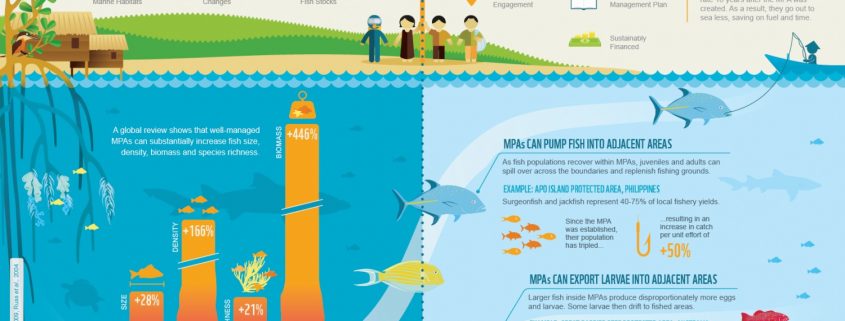Fishermen Views on Marine Protected Areas
By Alice Schreiber, RJD Intern
As fish stocks continue to decline, Marine Protected Areas are becoming increasingly popular methods of conserving marine habitats and preserving species. The success of these areas depends upon the existing legal framework, acceptance by the community, and an effective management system [1].
Being aware of how fishermen socially perceive MPAs is crucial when establishing them and creating management guidelines. MPAs are established areas where fishing pressure is reduced by designating the amount of fishing effort, time available for fishing activity, species that can be caught, gear permitted, or catch limits [2]. At times, Marine Protected Areas may completely restrict fishing or some areas may be designated Marine Reserves which function as no-take zones. The expectation is that the MPA will “maintain or restore marine biodiversity and ecosystem function,” as well as “improve socioeconomic conditions by increasing revenues from fisheries production due to an increase in the size and number of fish migrating out of the MPA [3]”. Without taking into account the stakeholders’ perception of the reserve, enforcing management of Marine Protected Areas would be nearly impossible.
A new study by Monalisa Silva and Priscila Lopez, sheds some light on how to determine fishermen’s perceptions of MPAs and what criteria influence the opinions the fishermen have about the MPA. When evaluating perception among fishers, four questions are asked: (1) if a fisherman born in a place subjected to the limitations of an MPA has a more conservationist attitude; (2) if young, part-time, non-selective fishers are more flexible and adaptable to changes in the reserves, (3) if full-time fishermen who were born in a community under the influence of an MPA have greater participation in the establishment of management; and (4) if fishermen born in a community under the influence of an MPA have more positive opinions than immigrant fishermen regarding the protected areas [2].
Asking these questions allows researchers and policy makers to understand which individuals within a community are less likely to comply with the regulations, and as such, which individuals would benefit from more education or incentives regarding the protected areas. Compliance will not be at adequate levels if there is not a proper understanding from the public of why MPAs are needed.
Three MPAs in the states of Rio Grande do Norte served as the location for the study, in which one hundred fishermen were interviewed. The fishermen were between the ages of 21 and 77 years old and had an average fishing experience of 29 years. They were split into four groups, depending on their age, birthplace, type of fishing gear, and their level of dependence on fishing. They then took a questionnaire, which assessed their perception of biodiversity conservation, flexibility and adaptability, participation in management, and opinions about MPAs.
The results of this study were able to confirm that older fishermen using selective gear have a more conservationist perception, full-time fishermen who use selective gear have lower flexibility and adaptability, and older fishermen tend to have more positive opinions regarding the MPA [2]. Flexibility and adaptability are important in regards to MPA compliance. Selective fishing gear allows fishermen to target a specific species or size of fish and when that fish stock collapses or is not longer allowed to be fished, they have very little flexibility in their choices. Encouraging fishermen to work in other areas part-time or to explore different resources beyond fish may help to ease the lack of flexibility.
Taking into account stakeholder perception is extremely important for the proper and effective management of MPAs. Compliance issues result from misconceptions of the conservational goals and from heavy dependence on fishing as their primary or only income. Being considerate of these issues allows for more effective management of MPAs and a more positive perception from fishermen and the affected community.
Works Cited
Salm, Rodney V., John R. Clark, and Erkki Siirila. Marine and coastal protected areas: a guide for planners and managers. IUCN, 2000.
Silva, Monalisa RO, and Prisicla FM Lopes. “Each fisherman is different: Taking the environmental perception of small-scale fishermen into account to manage marine protected areas.” Marine Policy 51 (2015): 347-355.
Pomeroy, Robert S., et al. “How is your MPA doing? A methodology for evaluating the management effectiveness of marine protected areas.” Ocean & Coastal Management 48.7 (2005): 485-502.






Leave a Reply
Want to join the discussion?Feel free to contribute!